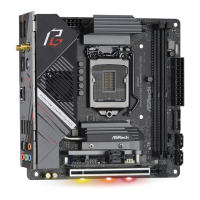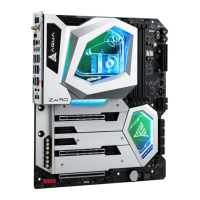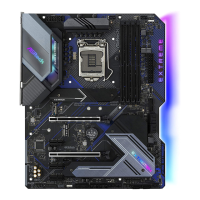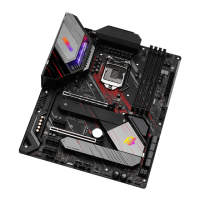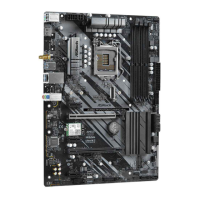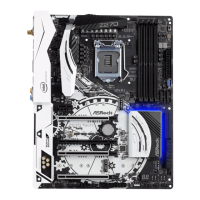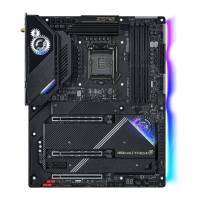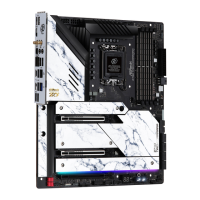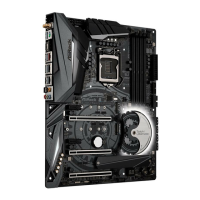Do you have a question about the ASROCK Z490 Taichi and is the answer not in the manual?
Lists all the items included in the motherboard package, such as cables, manuals, and accessories.
Details the technical specifications of the motherboard, including CPU, memory, expansion slots, and I/O.
Diagram showing the physical placement of connectors, slots, and headers on the motherboard.
Illustrates and describes the external input/output ports available on the motherboard's rear panel.
Details the integrated WiFi-802.11ax and Bluetooth module and its associated antenna.
Important safety and handling guidelines to follow before installing hardware components.
Step-by-step instructions for safely installing the CPU into the motherboard socket.
Procedure for mounting the CPU cooler and fan assembly onto the motherboard.
Guide on how to properly install DDR4 DIMM modules into the motherboard slots.
Details the different PCI Express slots and their configurations for expansion cards.
Instructions on how to use the CLRCMOS1 jumper to reset system parameters.
Diagrams and descriptions for various onboard connectors like front panel, USB, and audio headers.
Lists and explains the diagnostic codes displayed by the Dr. Debug feature for troubleshooting.
Guide for installing and configuring NVIDIA SLI technology with multiple graphics cards.
Instructions for setting up AMD CrossFireX, 3-Way CrossFireX, and Quad CrossFireX.
Detailed steps for installing an M.2 NVMe SSD into the M2_1 slot on the motherboard.
Detailed steps for installing an M.2 NVMe SSD into the M2_2 slot on the motherboard.
Detailed steps for installing an M.2 NVMe SSD into the M2_3 slot on the motherboard.
Guide on installing essential drivers and utilities from the motherboard's support CD.
Instructions on using the ASRock A-Tuning software for system monitoring and optimization.
Overview of the ASRock Live Update & APP Shop for downloading software and system updates.
Details the features and interface of the Nahimic high-definition audio software.
Guide to customizing RGB lighting effects using the ASRock Polychrome SYNC utility.
Explains how to access and navigate the UEFI BIOS setup utility for system configuration.
Description of the default EZ Mode screen, providing a dashboard of system status.
Details the structure and options available within the UEFI Advanced Mode.
Lists and explains the main menu categories within the UEFI setup utility.
Explains the keyboard shortcuts and navigation keys used within the UEFI setup utility.
Displays system information and allows adding/removing favorite BIOS items.
Configuration options for system overclocking, including CPU and memory tuning.
Covers various overclocking parameters like CPU V/F curves, DRAM timings, and PLL voltages.
Provides access to detailed system configuration options beyond basic settings.
Details settings for CPU, Chipset, Storage, Thunderbolt, ACPI, USB, and Trusted Computing.
Access to utilities like ASRock Polychrome RGB, RAID installer, and Instant Flash.
Monitors system temperatures, voltages, and allows fan speed control (Fan-Tastic Tuning).
Options for setting system passwords, Secure Boot, and Intel Platform Trust Technology.
Configures boot priority, fast boot options, and CSM compatibility support.
Options for saving changes, discarding changes, and loading default UEFI settings.
Lists all the items included in the motherboard package, such as cables, manuals, and accessories.
Details the technical specifications of the motherboard, including CPU, memory, expansion slots, and I/O.
Diagram showing the physical placement of connectors, slots, and headers on the motherboard.
Illustrates and describes the external input/output ports available on the motherboard's rear panel.
Details the integrated WiFi-802.11ax and Bluetooth module and its associated antenna.
Important safety and handling guidelines to follow before installing hardware components.
Step-by-step instructions for safely installing the CPU into the motherboard socket.
Procedure for mounting the CPU cooler and fan assembly onto the motherboard.
Guide on how to properly install DDR4 DIMM modules into the motherboard slots.
Details the different PCI Express slots and their configurations for expansion cards.
Instructions on how to use the CLRCMOS1 jumper to reset system parameters.
Diagrams and descriptions for various onboard connectors like front panel, USB, and audio headers.
Lists and explains the diagnostic codes displayed by the Dr. Debug feature for troubleshooting.
Guide for installing and configuring NVIDIA SLI technology with multiple graphics cards.
Instructions for setting up AMD CrossFireX, 3-Way CrossFireX, and Quad CrossFireX.
Detailed steps for installing an M.2 NVMe SSD into the M2_1 slot on the motherboard.
Detailed steps for installing an M.2 NVMe SSD into the M2_2 slot on the motherboard.
Detailed steps for installing an M.2 NVMe SSD into the M2_3 slot on the motherboard.
Guide on installing essential drivers and utilities from the motherboard's support CD.
Instructions on using the ASRock A-Tuning software for system monitoring and optimization.
Overview of the ASRock Live Update & APP Shop for downloading software and system updates.
Details the features and interface of the Nahimic high-definition audio software.
Guide to customizing RGB lighting effects using the ASRock Polychrome SYNC utility.
Explains how to access and navigate the UEFI BIOS setup utility for system configuration.
Description of the default EZ Mode screen, providing a dashboard of system status.
Details the structure and options available within the UEFI Advanced Mode.
Lists and explains the main menu categories within the UEFI setup utility.
Explains the keyboard shortcuts and navigation keys used within the UEFI setup utility.
Displays system information and allows adding/removing favorite BIOS items.
Configuration options for system overclocking, including CPU and memory tuning.
Covers various overclocking parameters like CPU V/F curves, DRAM timings, and PLL voltages.
Provides access to detailed system configuration options beyond basic settings.
Details settings for CPU, Chipset, Storage, Thunderbolt, ACPI, USB, and Trusted Computing.
Access to utilities like ASRock Polychrome RGB, RAID installer, and Instant Flash.
Monitors system temperatures, voltages, and allows fan speed control (Fan-Tastic Tuning).
Options for setting system passwords, Secure Boot, and Intel Platform Trust Technology.
Configures boot priority, fast boot options, and CSM compatibility support.
Options for saving changes, discarding changes, and loading default UEFI settings.
| DisplayPort version | 1.4 |
|---|---|
| PS/2 ports quantity | 1 |
| WiFi-AP antenna jack | 2 |
| USB 2.0 ports quantity | USB 2.0 ports have a data transmission speed of 480 Mbps, and are backwards compatible with USB 1.1 ports. You can connect all kinds of peripheral devices to them. |
| USB 3.2 Gen 1 (3.1 Gen 1) Type-A ports quantity | 5 |
| USB 3.2 Gen 1 (3.1 Gen 1) Type-C ports quantity | 0 |
| Front panel audio connector | Yes |
| Number of SATA III connectors | 8 |
| BIOS type | EFI AMI |
| ACPI version | 6.0 |
| BIOS memory size | 128 Mbit |
| System Management BIOS (SMBIOS) version | 2.7 |
| PCI Express x16 (Gen 3.x) slots | 3 |
| OpenGL version | 4.5 |
| DirectX version | 12.0 |
| Maximum resolution | 4096 x 2304 pixels |
| Parallel processing technology support | 3-Way CrossFireX, CrossFireX, NVLink, Quad-GPU CrossFireX, SLI |
| LAN controller | Dragon RTL8125BG |
| Wi-Fi standards | Wi-Fi 6 (802.11ax) |
| Bluetooth version | 5.0 |
| Ethernet interface type | 2.5 Gigabit Ethernet |
| Memory channels | Dual-channel |
| Memory slots type | DIMM |
| Number of memory slots | 4 |
| Supported memory types | DDR4-SDRAM |
| Maximum internal memory | 128 GB |
| Supported memory clock speeds | 2133, 2400, 2666, 2800, 2933, 3200, 3600, 3733, 3800, 3866, 4000, 4133, 4266, 4333, 4400 MHz |
| Cables included | SATA |
| Audio chip | Realtek ALC1220 |
| Certification | FCC, CE, ErP/EuP |
| Component for | PC |
| Motherboard chipset | Intel Z490 |
| PC health monitoring | FAN, Temperature, Voltage |
| Audio output channels | 7.1 channels |
| Motherboard form factor | ATX |
| Motherboard chipset family | Intel |
| Windows operating systems supported | Windows 10 |
| RAID levels | 0, 1, 5, 10 |
| Supported storage drive types | HDD & SSD |
| Supported storage drive interfaces | SATA III |
| Compatible processor series | Intel Celeron, Intel Core i3, Intel Core i5, Intel Core i7, Intel Core i9, Intel Pentium |
| Depth | 244 mm |
|---|---|
| Width | 305 mm |
